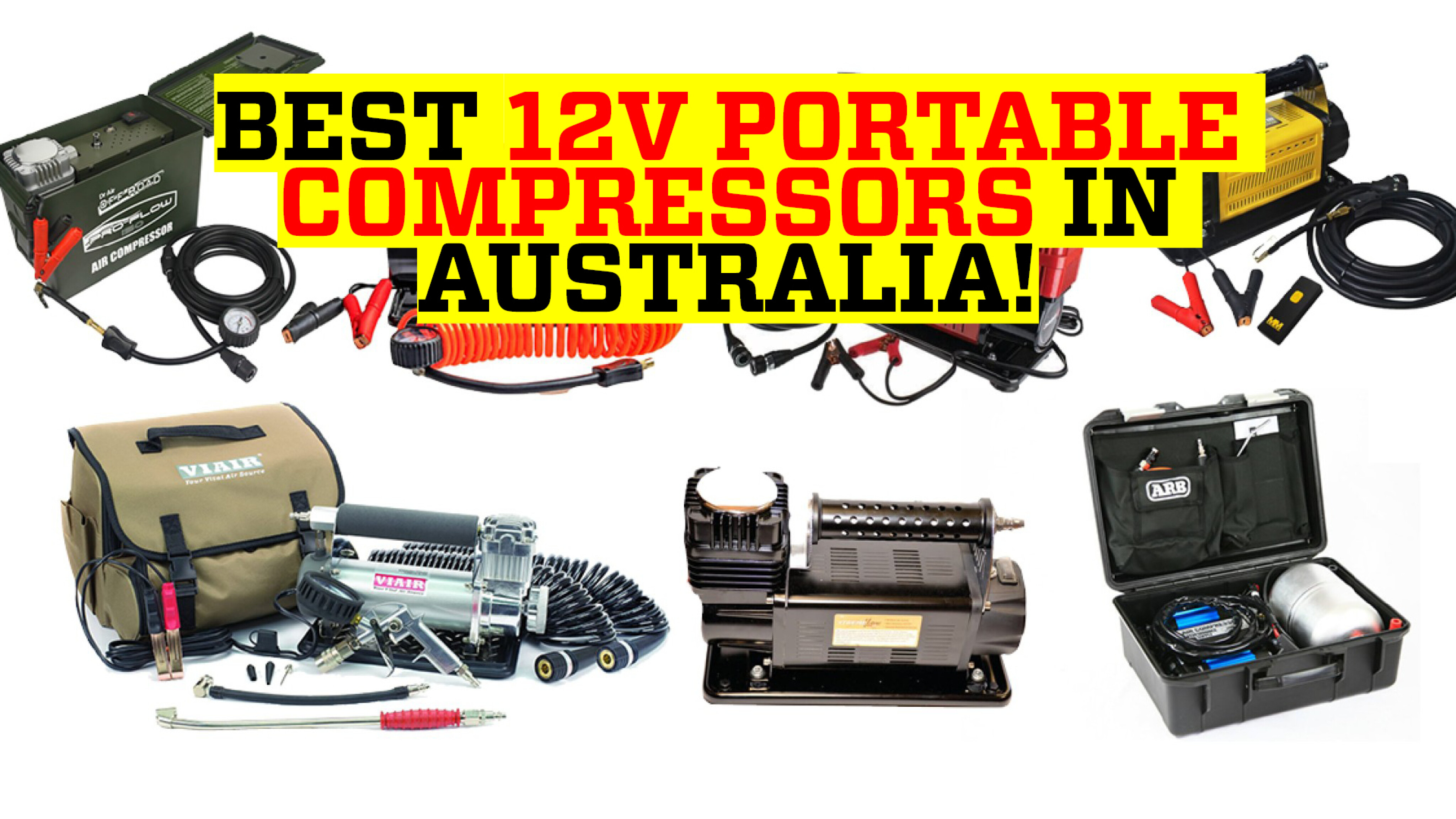
Not so long ago, there were only handful of 12V portable compressors on the market, and you chose the one you liked that fit your budget and away you went.
Fast forward a couple of short decades and the market has exploded, with every permutation and price of compressor imaginable now available. Some inflate tyres quicker than a politician taking credit for something they didn’t do while others struggle to blow up a footy.
These days you’re only a few mouse clicks away from getting a shiny new compressor delivered to your front door. However, nothing is worse than making an online purchase and it’s not up to the task – especially for something you just blew a few hundy on.
So, we thought it was time we put together a list of quality 12V portable compressors - ones you probably already know of, the ones you may not have heard of, and the ones that are available exclusively online but are top-shelf quality.
JUMP AHEAD
$500-$1000
$250-500
- DriveTech 4x4 air compressor
- Dr Air Ammo Box compressor
- RoadSafe 12V heavy duty compressor
- Mean Mother Adventurer 4 compressor
Under $250
ARB Twin Portable compressor kit
While the older-style single compressor kits are still available from ARB, they’ve recently doubled down and are offering the ARB Twin Portable compressor that comes with a four-litre air tank.
While one of the more expensive options on the list, this is an excellent choice for people undertaking extremely remote trips or who simply never want to buy another 12V compressor ever again. The twin motors incorporate internal thermal protection against extreme temperature damage, while a heavy duty in-line maxi fuse for each motor provides professional circuit protection.
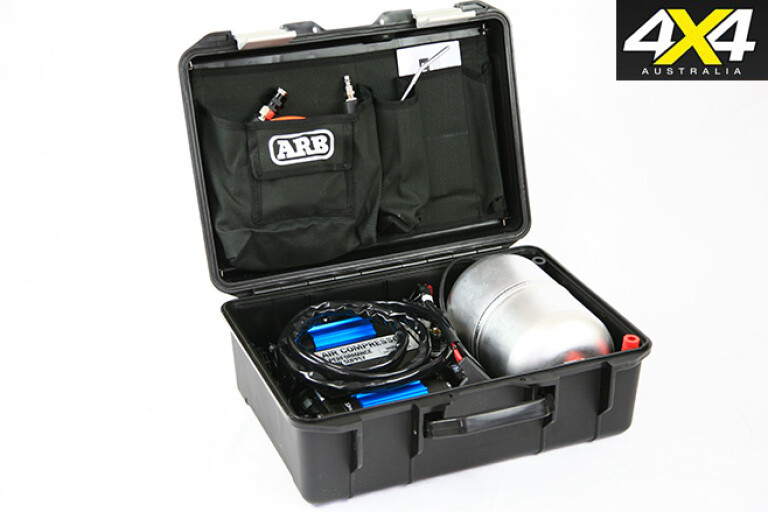
The portable kit comes with inflation accessories, a durable carry case, is sealed against dust and moisture, and features an over-pressure safety valve. Plus it's sealed for moisture and dust-resistance. They’re very quick to pump up your tyres, too.
| Current Draw | 50.4A |
|---|---|
| Air Flow | 131Lpm |
| Duty Cycle | 100% |
| Weight | 15kg |
Pros
- Performance
- Versatility
- Maxi-fuse protection
Cons
- Price
- Weight
- Bulky
Viair 450P-RV Automatic
A serious compressor for serious tyre inflation, the Viair 450P range comes with 100-per-cent duty cycle and the ability to pump a 35-inch tyre from 15-30psi in around 3.5 minutes.
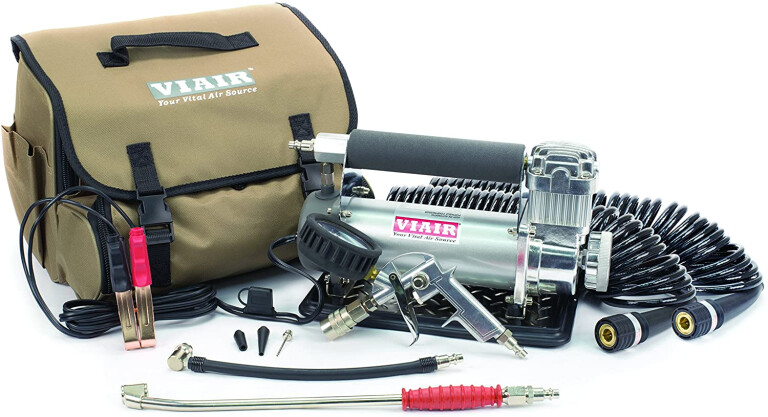
The unit can be run for an hour straight without rest periods and it pumps up to 150psi, making it ideal for vehicles with larger tyres. As the name suggests, it also comes with an automatic shut-off function which will turn the compressor off when it reaches a pre-set pressure, doing away with the whole back and forth “checking pressures as you fill your tyres” thing, reducing time and effort spent while airing up.
| Current Draw | 23A |
|---|---|
| Air Flow | 51Lpm |
| Duty Cycle | 100% |
| Weight | 4.9kg |
Pros
- Auto function a great inclusion
- Low weight
- Duty cycle
Cons
- Price point is up there
- One year warranty
- Lower flow rate
Drivetech 4x4 air compressor
Drivetech 4x4 steps things up in price a little, but it also steps up performance.

Utilising a twin-piston design that allows nearly double the performance over a single-piston unit, the Drivetech 4x4 compressor pumps a mammoth 300 litres per minute, to ensure airing up is as quick and painless as possible – nobody wants to be airing up in 40-degree heat or in the middle of a monsoon, so quicker is always better. Features include a pistol grip inflator at the end of an 8M hose, and it is stored in a heavy-duty bag with pockets for accessories.
| Current Draw | 45A |
|---|---|
| Air Flow | 300Lpm |
| Weight | 11.9kg |
| Warranty | 3 years |
Pros
- Excellent flow rate
- Twin-piston design
- Long inflation hose
Cons
- Three-year warranty
Dr Air Ammo Box compressor
This award-winning Pro-Flow air compressor from Dr Air has been designed for serious off-road use, flowing 150 litres per minute.
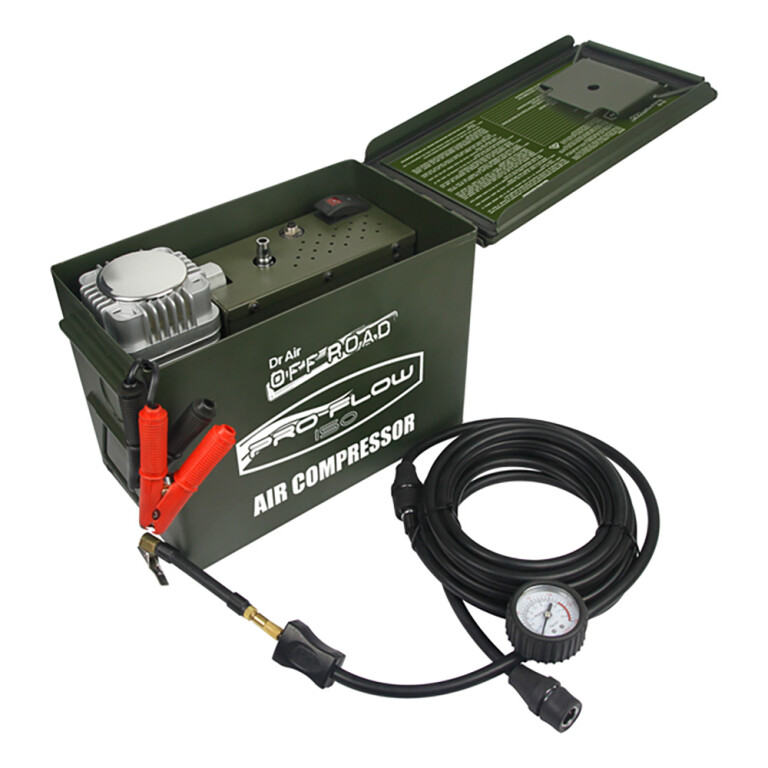
Featuring a heavy-duty ammo box housing, this is one tough unit with heaps of grunt. It has all the regular features that you'd expect in a compressor at this price point such as thermal overload and circuit breaker protection, and the 150psi output easily inflates the average 4x4 tyre (205/60R16) in around 2.5 minutes.
| Output | 150PSI |
|---|---|
| Flow rate | 150L per minute |
| Duty Cycle | 45 minute @ 40PSI |
| Weight | 11.2kg |
Pros
- Ammo Box design gets all the cool points
- Five-year warranty
- True portability – no need to remove from bag
Cons
- Low flow rate
- Heavy
- Potential condensation issues
RoadSafe heavy duty compressor
Roadsafe have built a great reputation for quality over the past decade in Australia, and its compressors seem to be continuing the tradition.
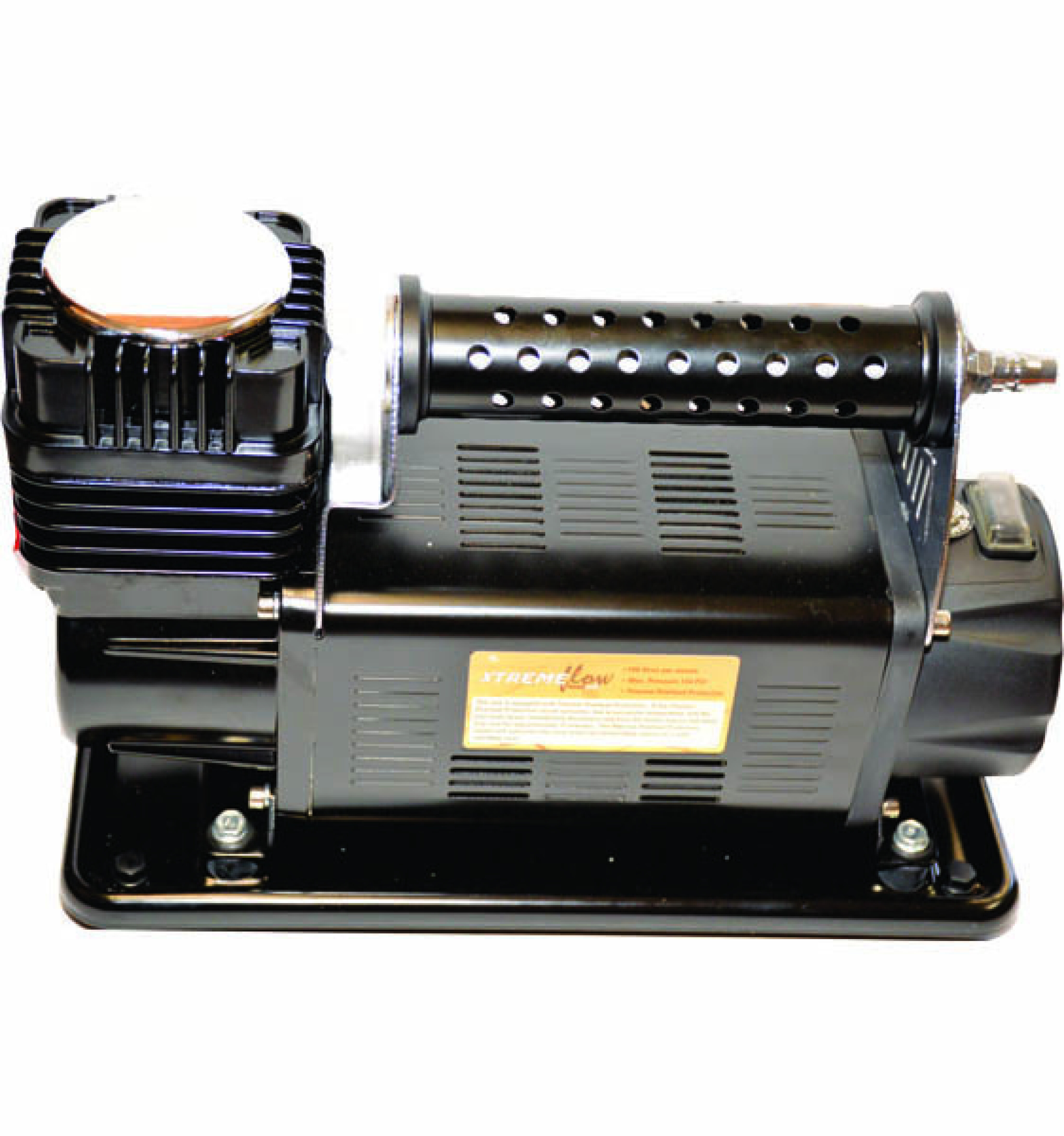
This heavy duty product flows 160 litres per minute, so you’ll be back up to road pressures after a day on the tracks in no time. It also has such inclusions as a resettable circuit breaker and thermal overload protection. For a no-frills, entry level compressor for the off-road enthusiast, this is a fantastic option.
| Max current draw | 45A |
|---|---|
| Air flow | 160L per minute |
| Warranty | 3 years |
| Weight | 10kg |
Pros
- Respectable all-round figures
- Good hose length
- Good inclusions for price point
Cons
- Three-year warranty
- Single piston design
- Gauge reliability
Mean Mother Adventurer 4 compressor
The Mean Mother Adventurer 4 Heavy Duty 12V Air Compressor is packed with plenty of inflation power, delivering an impressive 180 litres per minute of air delivery.

It’s equipped with all the standard features you’d expect in a compressor of this quality such as thermal overload and circuit breaker protection, as well as a premium wireless remote control. The remote allows the user to start and stop the inflation process and get accurate tyre pressure readings without having to go back and forth to the compressor to continually turn it off and on. The 150psi output will reportedly inflate an average 4x4 tyre (205/60R16) in around 2.3 minutes, and it comes with a five-year warranty.
| Air flow | 180Lpm |
|---|---|
| Duty cycle | 45min @40psi |
| Weight | 8.7kg |
| Warranty | 5 years |
Pros
- Great warranty
- Price
- Engineered for Aussie conditions
Cons
- No portable option on Pro Series
- Short hose length
- Reports of gauge accuracy issues
OZTrail Simpson compressor
The Oztrail Simpson air compressor can inflate the average 4x4 tyre from beach pressures to road pressures in less than 60 seconds.

It features a heavy-duty cast alloy 60mm cylinder bore, a 0.7hp motor, 160L per minute of flow, 150psi pressure ceiling, and a built-in safety thermal overload that protects you from running your compressor too hot. The rubberised dampener point reduces the vibration and noise created by the compressor and comes complete with an eight-metre air hose.
It also features 2.4-metre power cables with alligator clips for direct battery terminal connection, quick release and positive connection brass fittings with three valve adapters, incline radial pressure, and a carry bag for added convenience.
| Air flow | 160Lpm |
|---|---|
| Weight | 7.9kg |
| Warranty | 1 year |
Pros
- High flow rate
- Price point
- 0.7HP motor
Cons
- One-year warranty
- Single piston design
- Gauge reliability
A buyers' guide to portable 12V air compressors
A portable air compressor is an essential tool for the avid four-wheel driver. There are few products that are ‘must haves’ in the world of 4x4ing, camping and the great outdoors, but an air compressor is definitely one item that should be carried, as it can have so many handy and convenient uses – aside from tyre inflation.
It’s one of the most frequently used accessories, as situations constantly arise beyond the black stump that require a quick tyre-pressure change. They’re light-weight, easy to store, simple to use, and they won’t sting the hip pocket too much – plus, purchase the right attachment and you’ll be inflating your campsite mattress in next to no time.
Gone are the days of over-inflating the spare for emergencies, with a variety of different compressors now on the market. 12-volt electric compressors are by far the popular choice,but there are also engine-driven and battery-operated compressors to suit different needs.
So, if your adventures include traversing sand, dirt, mud, rocks and tarmac, there’s no reason to opt out when it comes to acquiring a portable air compressor.
Price
This is the tough one. We all want to spend as little as possible, but we also want the best out of our gear. We’ve managed to round up a number of compressors that are suitable for 4WD tyre inflation as well as general use around the campsite.
We’ve drawn a line at the units being portable; that is, they must be able to be carried and used from one vehicle to another – not engine-mounted or engine-driven. Of course, most of the compressors you see here can indeed be mounted in your engine bay, under your seats or in your cargo area, but they are all initially portable units.
Maximum pressure
If you want to pump up your tyres to 40-50psi, there’s no point purchasing a compressor that can only inflate low-pressure toys like soccer balls, air beds and kids toys. For low-pressure pumping that requires a large volume of air, all you need is a lower (maximum) pressure pump that has a flow rate as high as possible. Remember all those soccer balls, air beds and toys may have different openings, so be sure to look for varied fitments on the hose outlet.
Without knowing compressors’ internal specifications, there is no way of guessing the flow rates. That will depend on the bore, stroke, rpm, and internal design, as well as other restricting factors such as chuck type, air filter material, wiring gauge and length, and the temperatures reached while running. Just because one compressor seems identical to another, that doesn’t mean it’s the same inside – just like all car engines are not created equal, even though many are rated at the same cubic size!
Duty cycle
It’s important to have a good duty cycle in a compressor. Roughly, the duty cycle is the amount of time the pump is actually working when it’s turned on, compared to the amount of time it’s not working when it needs to cool down. For example, two minutes on followed by two minutes off is not very good when you’re trying to pump something up quickly.
Similarly, a (claimed) 50 percent duty-cycle pump may run for 30 minutes, followed by a long 30-minute wait. Perhaps that’s okay to re-inflate your four tyres after leaving the beach – but will that pump actually do the job within 30 minutes? I’d hate to be waiting another 30 minutes while the compressor cools down before you can finish that last tyre!
Officially, duty cycle should be measured with the compressor pumping at 100psi at an ambient temperature of 22°C. It is calculated by taking the run time and dividing it by the run time plus the off time, then multiplying the result by 100; the final figure is expressed as percentage.
For example: if a compressor is rated at a 25 percent duty cycle, it means it can only (theoretically) run for 10 minutes followed by 30 minutes turned off. So, 10 ÷ (10 + 30) × 100 = 25 per cent duty cycle – not 33 per cent as you might presume (10 ÷ 30 × 100 = 33).
An internal thermal cut-out switch is designed primarily to protect the air compressor’s motor from burning out or overheating. You’ll have no control over this thermal cut off; when the unit heats to a preset temperature, it (in theory) stops, leaving you twiddling your thumbs waiting for it to switch itself back on.
A 100 percent duty-cycle compressor, on the other hand, is great for our 4WD tyres, as well as those of all your mates who line up to use your pump – ’cause theirs keep cutting out!
Put simple, a duty cycle of an air compressor describes how long it can run and how long it needs to rest. “Duty cycle is the amount of continuous running time a compressor has,” Alderwick said. “This must be referenced with an operating temperature, a pressure, and a time period.
“One hundred percent duty cycle means a compressor can run continuously, but it still implies the requirement to stay within the reference conditions, and use outside of those conditions would lower the published duty cycle.”
Look for a duty cycle which allows you to inflate all of your tyres in normal conditions, without having to overwork or rest the compressor.
Why compressed air?
Altering tyre pressures changes the size of a tyre’s footprint, with larger footprints improving traction in softer surfaces like sand and lowering the risk of getting bogged or stuck, and smaller footprints ideal on highway runs.
To ensure tyre pressures are safely, securely, accurately and quickly modulated, it’s essential to have a no-nonsense tool that can be relied upon when the situation dictates.
Sure, pushing a twig on the valve needle may still be an effective way to drop tyre pressures down for a blast on the sand dunes, but these days, anyone who takes their off-roading seriously should be packing a portable air compressor to get the pressure back up.
“Air compressors are absolutely essential, as deflating tyres to tackle specific conditions will help get you out of tough places and with less stress on the vehicle,” ARB’s Shannon Alderwick said. “Having the reliability to inflate those tyres after driving at low pressures will ensure less tyre damage.”
Dip your toes into the air compressor market and you’ll notice there are both single- and twin-piston units available.
The single-piston offerings have been around the traps for yonks, with a tried-and-true formula of tyre inflation, albeit at a slow pace. Still, they’re lightweight, small in size and draw less power than their bigger siblings.
The twin-piston units can pump considerably more litres per minute than singles, yet come with a steeper sticker price and draw more power ... but you’ll be back on the tracks far sooner.
The majority of 4x4ers pack and run electric air compressors, with Ironman 4x4’s director of 4x4 products, Adam Craze, telling 4X4 Australia there’s good reason for this.
“They’re portable, fairly cost-effective, you can take them from vehicle to vehicle, and there’s nothing special required to run it,” he said. “Also, most come in a bag with attachments, and they can be mounted permanently.”
It’s this ease-of-use and versatility for remote-area use that appeals to the average punter, with electric compressors available in both fixed mountable and portable configurations.
“Mountable compressors come with a bracket system universal for many configurations ... for the most common places in a 4WD,” Alderwick said. “Using pneumatic lines provides the option to expand or change the system configuration with a range of fittings, joiners, and other components to suit any custom build.”
Another benefit of an electric air compressor is that you can reseat a tyre bead if it was to come away from the rim.
Engine-driven compressor
Should you require an even greater flow rate, there are engine-driven air compressors available, which, as the name implies, are mounted to a vehicle’s petrol or diesel engine, to generate an endless supply of compressed air.
One of the main benefits of an engine-driven air compressor is that they provide much greater output than the 12-volt units, are highly efficient and have the ability to stay cool and run for a much longer time. However, as they must be belt-driven, a common problem is finding space for the unit in the busy engine bays of modern vehicles.
Australian company Endless Air began producing compressors back in 1995. Its unit is a five-piston design that runs from a petrol or diesel engine through an electric clutch.
What to look for
Browsing catalgoues for a new air compressor might be an overwhelming task, but there are a few key features to look for when buying one for that next 4x4 trip.
As always, it’s important to establish early on what your off-roading intentions are – will you spend your time blowing up the kids’ pool at a campsite? Or will you be lowering tyre pressures to reach that bucket-list campsite? If the latter, you’ll want a heavy-duty unit that’ll serve its purpose; if the former, well, just get a foot pump.
As well as researching flow rates, max current draws and duty cycles (see pages 98 and 99), there are a number of key cogs that comprise a quality compressor. We asked the experts at Ironman 4x4 and ARB to highlight the key features to look for when buying an air compressor.
“Reliability of components including wiring, connectors and switches to ensure it always works on any occasion,” Alderwick told us, with Craze adding: “Note how long is the hose, what is the duty cycle and how many amps does it draw. (Look at) litres per minute versus the size of your tyres. Also, size for storage. If you have a van, will it reach the camper or van tyres.”
If opting for a twin-piston compressor, keep an eye out for products with twin motors to power the pistons separately, providing further insurance if one piston goes bang.
“This ensures two motors can run independently at full performance while allowing the compressor to continue if there was ever a failure of one motor. The other motor then produces the same qualities as a single ARB compressor,” Alderwick said.
Another consideration – as with any 4x4 aftermarket purchase – is to research the brand you are buying from, specifically warranties, service network and parts availability.
Remember, you get what you pay for. Make an error in judgement and swipe the credit card for a cheap and nasty inferior product, and it might come back to bite you ... or catch fire.
“Underrated, poor wiring quality presents a fire risk while in use due to the current requirements of a compressor,” Alderwick said. “Undersized fuse holders holding larger amp fuses result in melted wires and failure. (Plus) no overpressure protection, which in warmer climates produces extreme temperatures, deteriorating seals and can cause fires.”
Alderwick said some companies have been known to publish fraudulent performance specs which could cause failure before reaching claimed limits.
Craze added: “Some products may look the same outside but internally are very different, like plastic gears or pistons.
Some hoses will melt or blow holes due to the heat, or small wiring that doesn’t cope with the power requirement.” Research, research, research!
Flow rate and max current draw
You're bound to encounter the terms ‘Flow Rate’ and ‘Max Current Draw’ when hunting for a new compressor. Flow rate of an air compressor is the ‘generated litres per minute of the compressed air’, while max current draw is the highest number of amps a manufacturer would expect the compressor to consume under any standard operating conditions.
For example, look through the spec sheets and you might see a flow rate of 70lt/min and a max current draw of 65.5amp, this means it’ll have a flow rate of 70 litres per minute and a max current draw of 65.5 amps.
In relation to max current draw, Alderwick said: “A lower current draw will demand less of the vehicle’s electrical system, however lower currents will often reflect lower performance.”
How we review products
4X4 Australia has been reviewing four-wheel drive vehicles, aftermarket products and camping gear for more than 40 years. When looking for the best swags in Australia there are some things that are essential to ensure you sleep soundly under the stars.
When we compared each of the swags in the list with hundreds out there we looked at the size, weight, durability and price. We also searched for additional features that make these swags stand out from the rest.
We looked at hundreds of user reviews and drew on our own experience sleeping in swags to make sure our recommendations are for the best on the market.
Disclosure: When you buy through our links, we may earn a commission. We also include products that we do not earn a commission from.

COMMENTS